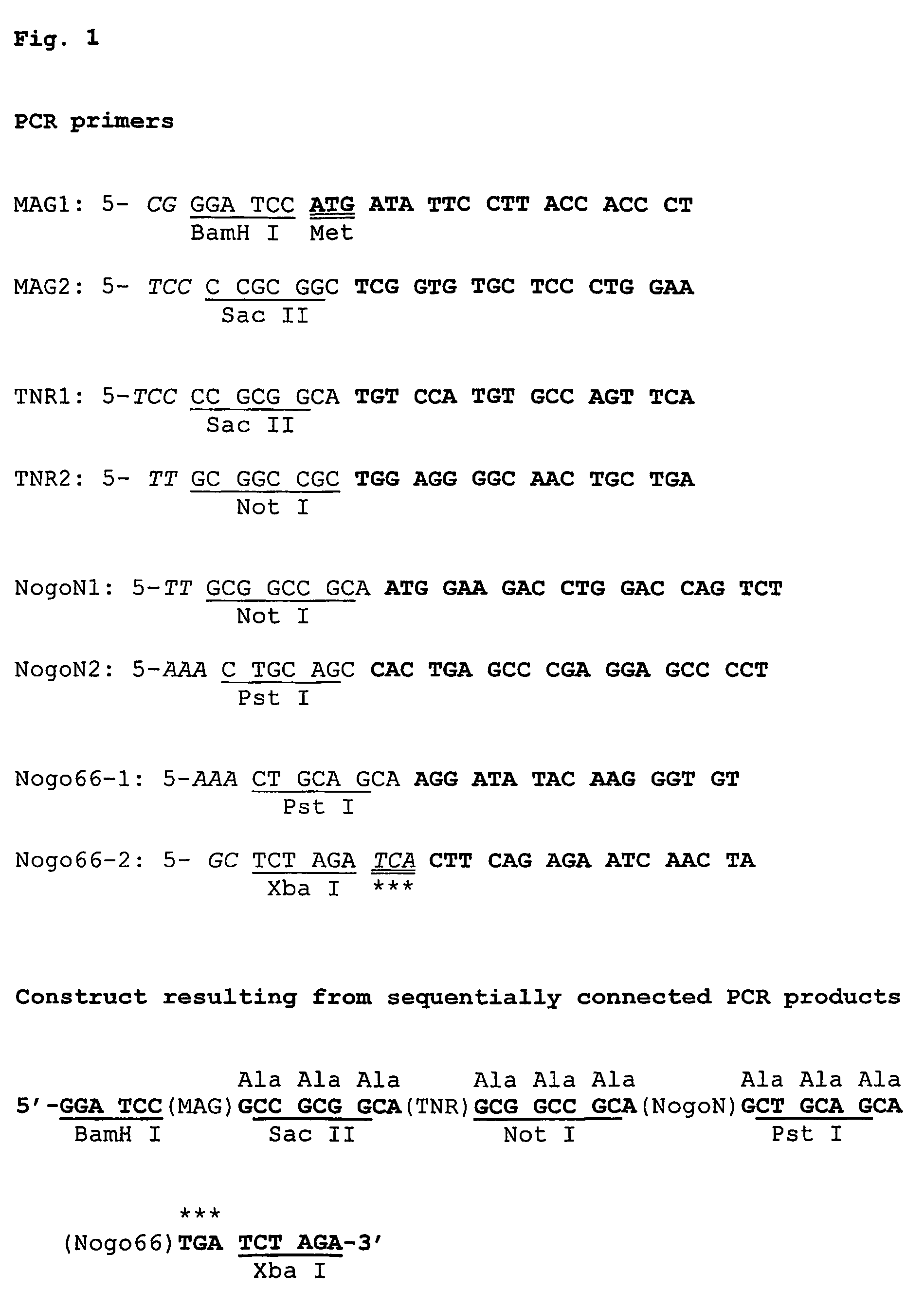Peptides, antibodies thereto, and their use in treatment of central nervous system, damage
a technology of central nervous system and antibodies, applied in the field of peptides and antibodies thereto, and their use in the treatment of central nervous system, can solve the problems of inability to immunize subjects, inability to achieve axonal regeneration, and inability to achieve the effect of correct folding of domains
- Summary
- Abstract
- Description
- Claims
- Application Information
AI Technical Summary
Benefits of technology
Problems solved by technology
Method used
Image
Examples
example 5
ASPECT 1, EXAMPLE 5
In Vivo Test for Peptides that can Alleviate Spinal Cord Injury
[0167]Those consensus short peptides that can neutralize the inhibitory effects of TN-R, MAG and / or Nogo in vitro are used in vivo to determine that they alleviate spinal cord injury (Bregman et al, 1995). These peptides are injected into spinal cord injured adult rat. Regeneration of axons is assayed by immunohistochemistry by comparison with an untreated control. Function improvement is also analyzed.
example 6
ASPECT 1, EXAMPLE 6
Screening for Candidate Factors that can Abolish the Inhibitory Effects of TN-R, MAG, and / or Nogo
[0168]Degenerate oligonucleotide sequences are determined for the peptides that can neutralize the inhibitory effects of TN-R, MAG and / or Nogo in vitro and / or in vivo (preferably both). EST databases (preferably databases of CNS-derived ESTs) are searched using the degenerate oligonucleotide sequences. CNS cDNA libraries are screened using labelled degenerate oligonucleotide probes. Hits represent candidate factors that can abolish the inhibitory effects of TN-R, MAG and / or Nogo. These candidate factors are purified as GST-fusion protein, and the neutralizing effects are tested as described previously for the peptides.
[0169]An alternative way to test the neutralizing effects in vivo is to transplant candidate factor-transfected neurons to the injured spinal cord in an experimental animal and observe the neutralizing results.
[0170]New factors that can abolish the inhibi...
example 1
ASPECT 2, EXAMPLE 1
Vector Construction
[0171]Nucleic acid encoding the following domains was obtained by PCR: N-terminal and 66-Aa extracellular domain of Nogo-A, third to fifth Ig like domain of MAG and the EGF like domain of human TNR.
[0172]PCR primers were designed to include restriction enzyme sites and to encode Ala linkers at the ends of the subcloned sequences (see FIG. 1). Therefore, when the PCR products were double digested by restriction enzymes and then connected sequentially, DNA encoding the Ala linkers was located between each pair of neighbouring domains (again, see FIG. 1). The Ala linkers facilitate proper folding of the domains.
[0173]Then, the sequentially connected DNA was double digested by BamH I and XbaI and then inserted into a pcDNA 3.1 vector (Invitrogen) to produce a recombinant vector. The recombinant vector was verified by agarose gel and sequence analysis.
PUM
| Property | Measurement | Unit |
|---|---|---|
| temperature | aaaaa | aaaaa |
| pH | aaaaa | aaaaa |
| pH | aaaaa | aaaaa |
Abstract
Description
Claims
Application Information
 Login to View More
Login to View More - R&D
- Intellectual Property
- Life Sciences
- Materials
- Tech Scout
- Unparalleled Data Quality
- Higher Quality Content
- 60% Fewer Hallucinations
Browse by: Latest US Patents, China's latest patents, Technical Efficacy Thesaurus, Application Domain, Technology Topic, Popular Technical Reports.
© 2025 PatSnap. All rights reserved.Legal|Privacy policy|Modern Slavery Act Transparency Statement|Sitemap|About US| Contact US: help@patsnap.com

